that effect marketing, business, e-business, and int'l business
| o
Competitive
o Economic o Geographic |
o
Political / Legal / Regulatory
o Sociocultural o Technological |

| the
6 Environments
that effect marketing, business, e-business, and int'l business
|
 |
Geographic Environment
see also
witiger.com/internationalbusiness/physicalgeographicenvironment.htm
see also witiger.com/internationalbusiness/geographicenvironment.htm
Sociocultural Environment
see also witiger.com/marketing/cultures.htm
see also witiger.com/internationalbusiness/culturalconsiderations.htm
see also witiger.com/internationalbusiness/badtranslation.htm
Political / Legal / Regulatory
Environment
see also witiger.com/internationalbusiness/politicalenvironment.htm
see also witiger.com/internationalbusiness/politicalrisk.htm
see also witiger.com/internationalbusiness/politicalriskcontingencyplanning.htm
see
also witiger.com/internationalbusiness/personalrisk.htm
Economic Environment
see also witiger.com/internationalbusiness/economicenvironment.htm
Competitive Environment
see also
witiger.com/ecommerce/competition.htm
see also
witiger.com/marketing/typesofcompetition.htm
see also
witiger.com/ecommerce/competitorintelligence.htm
see also
witiger.com/ecommerce/competitorintelligence-asia.htm
see also
witiger.com/ecommerce/cannibalization.htm
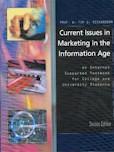 |
this unit is
in the text
"Current Issues in Marketing in the Information Age, 2nd. Edition" on page 1 - 11 |
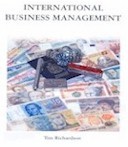 |
this unit is
in the text
"International Business Management" on page 63 - 78 |
| . | This page
used in the following courses taught by Prof. Richardson
.
|
| LEARNING
OBJECTIVES |
The objectives
for this unit are to help the reader understand
o the role
played by each of the 6 environments in business
When the reader has completed this unit it would expected that they could read information about a marketing, business or international business situation and analyze this in terms of what environments are involved and how they exerted influence WTGR |
| INTRODUCTION | A basic education
in business and marketing at the college or university level gives the
student an understanding of the 4P's - things you can do something about,
and the 6 environments, - things you cannot do anything about.
The 4P's are things
you can change
the 6 environments that
effect business are not things you can change
o Competitive Environment
|
| INTRODUCTION | How you react
to the influences of the 6 environments is the key to your success.
You can monitor the changes in an environment and plan accordingly, or you can just react as each situation develops and hope to survive. Successful companies are the ones who see trends developing and plan in advance to deal with the anticipated changes. Understanding the effect of the environments, that influence business, is a major part of a good marketing education. Many times in the semester we will discuss various topics and these discussions will invariably include some aspect of how the topic is effected by the 6 environments. When you read the list of 6 environments below, keep in mind some current business stories in the newspaper and see if you can apply each of the environments to the story. WTGR |
|
These are all the environments mentioned in various texts and other sites, which effect business
All of these environments influence int'l business and e-commerce, but the ones in bold, highlighted in red below are the ones we will concentrate on in this unit
|
| Economic / Financial | The Economic
/ Financial environment includes considerations such as the
|
| Political
/
Legal / Regulatory |
The Political
/ Legal / Regulatory environment is often a direct consequence
of the political parties in power, which represents the popular opinion
of the citizens of the region. If the citizens are, for example, pro-Big
Business then probably taxation will be modest and there will not be a
lot of stringent rules about environmental considerations.If the citizens
are very concerned about safety issues, for example, then there will
be a lot of rules and regulations governing things such as transportation
safety, which will make it more expensive for some companies that have
big shipping costs.
The rules and regulations created by the politicians, have significant influence on the cost of running a business and the way it can market products and services - for example in Canada there are severe regulations about advertising for alcohol and tobacco. Examples of influences of the political environment include
|
| Sociocultural
/
Ethnic / Linguistic |
The Sociocultural
/ Ethnic / Linguistic environment is more and more influential
especially in multi-cultural urban areas such as Toronto, New York, London,
etc.
For companies selling industrial products, which are often simply marketed by dimensions (size, weight, height etc.) there is not a strong requirement for documents and packaging material to be "culturally sensitive". For companies selling consumer
products, particularly food and clothing, it is increasingly important
to use all the languages of your customers in your promotion campaigns
and communicate effectively with your target demographic.
Examples of influences of the socialcultural environment include
|
| Technological | When most people
think of the Technological environment
the first thing that comes to mind is whether or not they "have the Internet".
This is only one part of the world of business. The technological environment
could be something as simple as whether or not vendors use Interac to receive
payment, or do you have to pay cash. The technological environment also
covers road and rail and ocean transportation as well as communications.
The ability of a company to be competitive also includes access to high
speed communications - some parts of the world have highly developed fiber
optic cables, other parts don't even have land lines for phones. In some
parts of Africa, technology has been delayed for decades, but when it did
arrive, they skipped directly to cell phones without even bothering to
put in telephone poles and land lines.
One of the key characteristics of the technological environment is that the infrastructure is very expensive. It is usually a national government who funds the projects that allow telephone and cell phone networks to be constructed. The degree to which a region has an advanced technological environment is often related to the health of the economic environment which would contain the companies that are making money, and paying taxes, to support the government funds spent on the infrastructure. |
| Physical / Geographic | The Physical
/ Geographic environment includes
o weather and the effect on agriculture, travel, building design o distance, distance to travel, time zones o topography - mountains, flat land and the effect on transportation systems o latitude, is it tropical or arctic, number of days and hours of sunshine In some courses we refer to only 5 of the environments; leaving out geography, because most people think the Web transcends geography. In reality, it is not so simple. Geography has a big place in e-commerce, especially when you think about the influences of distance to ship products sold online, and when you think about how geography influences the social-cultural environment (language, customs, etc.) Geography also effects weather and weather has an effect on the internet from a technological point of view. Weather situations can cause disruption of communication lines which means the "web is down" in parts of the world effected by a crisis. In some places effected by an earthquake, or tsunami, it can takes days or weeks for telecomm services to be restored and in that time period web based services cannot be accessed in the effected region. |
| Physical / Geographic | The geographical
environment also includes topographical challenges and advantages. Challenges
apply when the land is very steep, which limits the available acreage of
arable land so you cannot grow enough crops (like n the sides of steep
hills or old volcanoes as in the case of Japan). Advantages take place
when the land is flat, and the soil is rich in nutrients, like in our prairie
provinces of Manitoba, Saskatchewan and Alberta. This land Canada has in
the middle of our country gives us an incredible advantage in terms of
being able to grow our own food. Countries who have geographic environmental
limitations have to import massive quantities of food which is expensive
and, to some extent, effects the national sovereignty.
While the Competitive Environment is perhaps the most powerful environment in terms of influencing whether we do, or don't do certain things, it should be understood that the Geographic environment is also powerful in the sense that negative things effecting the planet can have long term negative consequences for the ability of companies to sustain their activity - examples include New Orleans and the time spent recovering from the hurricane and as well as regions in South Asia effected by the massive tsunami in December 2004 see also witiger.com/internationalbusiness/physicalgeographicenvironment.htm
|
Competitive
Environment
 |
The
Competitive Environment is, perhaps, the most important of the 6
Environments that influence a company involved in marketing, business,
International Business or e-commerce.
The degree to which one
attends to the "other" environments is a consequence of the intensity of
the Competitive Environment.
|
| Competitive Environment | If the Competitive
Environment is intense, meaning,
you have a lot of companies trying to - copy your product and knock off your designs, - sell below your price, - use your same themes for advertising, - paying better wages to employees, - sell a slightly different product that can be substituted for your's, it will be necessary to o utilize every resource in the technological environment, o attend to all the considerations of the social/cultural environment o carefully analyze trends in the economic environment o monitor political movements and upcoming changes in the regulatory environment o prepare contingencies for threats from weather extremes and the geographic environment .. if the Competitive Environment is NOT intense, then you don't have to use the latest technology, because your customers will not be drawn to anybody else, you do not have to worry about the language considerations of the Social/Cultural Environment, because you have no competition who will provide better service, etc., |
| The
Six
Environments A Case Study |
To assist in understanding
the importance of "applying" an understanding of the 6 environments, we
will analyze a 2003 story in the context of what environments are influencing
this particular trade situation.
In 2003 Nov 3rd, a story appeared in The Toronto Star. The story came off the Canadian Press feed and was about the current problems Canadians are having resurrecting the Canadian beef export market to Japan WTGR |
| Title: "Don't
ship Canadian beef, Japan to tell U.S."
"TOKYO—Japanese Agriculture Minister Yukio Hattori will ask the United States to ban the exportation of Canadian beef bound for Japan via the United States, citing continued concerns over mad cow disease, according to media sources in the Japanese capital. The Japanese request comes in response to the American intention to start importing veal from Canada early next year....According to the sources, the Japanese Ministry of Agriculture, Forestry and Fisheries will be requesting that the U.S. start certifying the origin of all its beef products intended for export to ensure that nothing has come from Canada. ...Both the United States and Japan closed their borders to Canadian cattle and beef products after a single animal was diagnosed with mad cow disease in Alberta last May [2003]. The U.S. and Canadian cattle industries were highly integrated up until the mad cow scare. Canada has traditionally sold more than 70 per cent of its live cattle to the United States. permission to quote from the Toronto Star given by Joanne MacDonald (TORSTAR SYNDICATE SALES) in emails in 2004. Copies of emails kept on file in the permissions binder. |
| Canadian
Beef to Japan
- effected by the Competitive
|
As a result
of losing export sales to U.S. processors, (because of limitations in exporting
to Japan) and a high Cdn dollar, Canadian cattle producers may be challenged
by beef exporters from Argentina and Australia - two other countries which
are international competitors in beef exports.
Japanese declines in importing beef may effect the competitiveness of other Canadian meat product exports such as pork or chicken since meat importers usually handle all three of those products. This is a good reminder that sometimes your ability to do business internationally can be effected by the success or failure of other companies in your business sector who are selling slightly different products. |
| Canadian
Beef to Japan
- effected by the Political / Legal / Regulatory Environment |
Laws and regulations
are a consequence of what the government wants to control, which
is a consequence of politics - meaning what is the government doing, or
not doing, to maintain the confidence of the people and get re-elected.
The Political Environment in this situation is influencing the Canadian Beef exporters through the new regulations that the Japanese government has established. These Japanese regulations (which are a consequence of the Sociocultural Environment - people in Japan fear Mad Cow) will mean that U.S. beef producers cannot send beef products to Japan if some of that beef came from cattle they imported from Canada. Example - frozen hamburger patties manufactured in the U.S. for export to the McDonald's outlets in Japan. |
| Canadian
Beef to Japan
- effected by the Economic Environment |
As a result
of losing export sales to U.S. processors, Canadian cattle producers will
be economically constrained and this will have a negative effect on the
economic environment in the province of Alberta and Saskatchewan.
The high value of the Canadian dollar from Q2 of 2003 through to Q3 in 2004 will make it further challenging for Canadian beef exporters to sell their product at a competitive price since importers will have to pay more. |
| Geographic
Environment - distance to travel - weather - temperature ? growing season |
Distance - Canada
is much farther way from the markets in Tokyo and Osaka than Australia.
Australia's close distance to Japan gives it an advantage in quoting prices
because their shipping costs will be lower and the time the product is
"in transit" is less than a Canadian export. If the time "in transit" is
less, then the product is more fresh. Canadian exporters are at a disadvantage
when the distance to the customer is farther than another source in Australia
or New Zealand.
Canada is a northern country. We have winter!! American cattle producers have less weather extremes to contend with than Canadian cattle producers, therefore it is more costly for Canadian cattle producers to feed their herds. Because it is colder in Canada, you have to feed the cattle more grain because these animals burn more calories in colder weather. Overall, it costs more to bring animals to market due to the challenges of the weather and our colder climate. |
| Technological
Environment - bio-science - hormone supplements - DNA analysis of breeding |
Agriculture
products (a consequence of the richness Geographic environment) are effected
by developments in bio-sciences such as hormones which make animals mature
faster and gain muscle mass. Technological developments also produce variations
in breeding that allow for animals and plants to grow faster and more quickly
with varying nutrients. For example: - Canadians have used bio-technology
to develop strains of grains that will grow in colder soil and mature in
a shorter growing season.
Future developments in bio-sciences may mean an end to BSE - bovine spongiform encephalopathy [Mad Cow disease] and therefore we might see the removal of restrictions on beef exports since there would no longer be fear of this disease effecting humans. |
| Sociocultural
Environment - languages - lifestyles - diet and food preferences - ways of cooking
|
Despite great
marketing efforts by the Canadian government and the CBEF - Canada Beef
Export Federation, Japanese people still do not eat a lot of beef as part
of their diet. While the younger generation in Japan eat western style
fast foods - the per capita consumption of beef is not as large as in North
America and Europe. Japanese protein sources are mostly from the marine
products (fish, squid, whale meat, seaweed), pork and poultry they eat.
This is a part of Japanese culture which is hundreds of years old and unlikely
to change in a short time.
Raising cattle in the grasslands of Alberta is also part our Canadian sociocultural environment. If this lifestyle is lost due to problems exporting beef, it will be a big problem to the thousands of families in Western Canada who are 2nd and 3rd generation cattle farmers. These people are not easily converted into website designers or other new millennium workers and it would be heartless to expect them to make such a sacrifice. |
| A good example of different
levels of intensity in the competitive environment can be seen in November
2003 when Ford started selling the new F150s in the U.S. and Canada. In
the U.S. market there was lots of competition from G.M. and Dodge so Ford
had to give big discounts to penetrate a "price competitive" market and
make sales. In Canada, Ford F150 had a great market share so they did not
give discounts.
Rob Ferguson, Business Reporter with the Toronto Star wrote about the F150 in November 2003 |
| Ferguson's story in November
2003 was titled
"Competition forces Ford to discount F-150: Incentives won't apply in Canada Decision comes despite strong sales"
permission to quote from the Toronto Star given by Joanne MacDonald (TORSTAR SYNDICATE SALES) in emails in 2004. Copies of emails kept on file in the permissions binder. |
| A good example of how the
competitive environment internationally, can effect jobs here at home,
is found in the 2003 Toronto Star story about Stelco of Hamilton.
Rick Westhead wrote 2003
Nov 7th about Stelco having to layoff employees
|
| Competitive
Environment effecting Technology Products |
Netflix, which first announced intentions to cut its $21.99 rental price on Oct. 14, [2004] said customers can now rent as many DVDs as they want for $17.99 per month. WTGR says, "while Netflix may be successful at scaring away competitive with this low entry price strategy, their profits will be very low and this might be challenging unless the company has income from some other product line." |
| Competitive
Environment effected by the Technology Environment |
'Yahoo announced last week that it had integrated its FareChase technology into its main search engine, so that it can scan multiple sites for airlines, hotels and car rentals and show the lowest-price offers directly in results whenever someone types in, say, "lowest fares to Las Vegas." |
| Sean added This
demonstrates the direction of e-business and how there is direct
competition on the internet, with company prices going head to head with such fee finders as Yahoo's farechase. The online travel business is huge and with Yahoo developing this easy to use fare finder we can see that the business will continue to grow. Customers are always looking for the lowest price and Yahoo has given them a utility to view the lowest price with ease. WTGR says, "Sean, I think this is an interesting example of how a technical capability has created a situation where companies are, in a sense, exposed competitively and it might be better for the consumer, but will see how it is in terms of changing corporate price planning" |
| Economic
Environment
effected by the Social / Cultural Environment |
|
| Dana Flavelle, Toronto Star
reporter wrote an article 2005 March 5th titled
Weston Puts Closing Sign on 2 Plants: U.S. Operations suffering from low-carb craze In this story, Flavelle writes "North America's third-largest bakery, George Weston Ltd., is closing two plants and cutting 1,100 jobs as consumer tastes shift away from sweets and white bread and more toward healthier whole-grain products....The company, owned by Canadian billionaire Galen Weston, said all of the jobs cuts are in the U.S....The latest cuts affect Weston's Interbake division, a company it has owned since 1946 and which makes about half the Girl Guide cookies sold in the U.S., along with other baked goods. The cuts come as little surprise to analysts who follow the industry, which has been struggling to keep up with consumers' rapidly changing tastes." permission to quote from the Toronto Star given by Joanne MacDonald (TORSTAR SYNDICATE SALES) in emails in 2004. Copies of emails kept on file in the permissions binder. |
| Technological
Environment
new phone area codes |
1. the massive numbers of immigrants from India and China + other asian countries which is driving up smartphone usage rates 2. the increasing number of devices and applications that use a mobile telephone number to connect with web based applications, such as video surveillance cameras |
| Technological
Environment
disrupts the Social & Economic Environment - job losses |
I was arguing with my friend the other day about the amount of people that became homeless because of the dot-com bust. She found it impossible to believe that more than a few people became homeless as a result of the dot-com failures. I thought this was an interesting article that I sent to her too. It says that in Silicon Valley alone, upwards of 18,000 people became homeless as a result of the bust. Just thought it was interesting. http://extremepreneur.weblogger.com/stories/storyReader$79 Cheers, Drew WTGR adds - massive changes in the Technological Environment - which may lead to large job losses, would change the Economic Environment because fewer people would have money for buying consumer items. As economic prosperity drops, people end up living in stressed situations, which may lead to crime and violence - which in turn effects the Social-Cultural Environment. |
| Technological
Environment
The
|
|
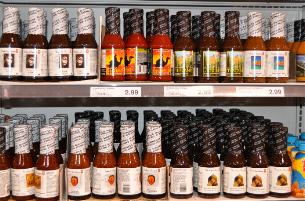 |
Food and clothing are two
of the consumer product categories most influenced by changes in the Social-Cultural
Environment.
When Prof. Richardson was walking through the aisle with BBQ sauces and ketchups in his local grocery store, he noticed the incredible variety in just one category of President's Choice BBQ sauce, which appears to have attempted to "represent" every possible ethnic group that might be shopping there. Click on the pic to the left and you can see the range of flavours. |
 |
You don't need Stats Canada's
Immigration figures to tell you that the growing number of Asians in Canada
has an influence on marketing.
Just look at the fact that Szechwan BBQ sauce flavour is so common, and popular, it even comes in a Diet version - and this is in a grocery store 60km NE of downtown Toronto !! |

|
The
Canadian banks, which are VERY competitive, and have a virtual oligopoly
in the Canadian market (by virtue of the political/regulatory environment)
are very aggressive at following the latest trends in the social-cultural
environment - a simple example is the languages offered to serve customers.
For several years now, CIBC, TD, and RBC have used Chinese characters on the signs of their branches in the Spadina - Queen St area of Toronto. One of my former students who works at RBC in 2006 showed me that RBC now has bilingual voice mails - NOT English/French but English/Chinese; as a way of pandering to a growing demographic that the banks want as customers. |
 |
Srivithya K.
in BCS 555 in Sept 2004 found a great example of a website that illustrates
awareness of the impact of the Social-Cultural environment - the
TTC.
This is a good example of serving other languages because mass transit systems are used by people from all classes of society and all ages. |
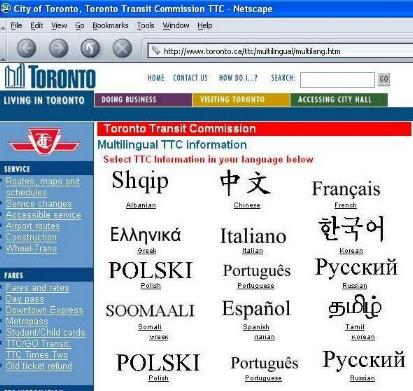 |
Usually you can tell how international a city is by the way signs are posted in public places. |
 |
This photo was taken by
Prof. Richardson when he and his wife were walking around Spadina, as they
often do on a Saturday afternoon
There is no law saying building signs have to be in English & Chinese (in fact, English and French are the only official languages in Canada) but the high concentration of Chinese people in this area of Toronto means that commercial businesses (in a competitive environment) |
sn
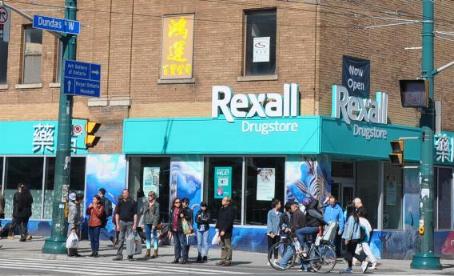 |
2018 Update
This photo was taken by Prof. Richardson when he and his wife were walking around Spadina April 2018 - the RBC Bank is no longer there - a drug store has taken the corner space. |
|
|
CONTACT I MAIN PAGE I NEWS GALLERY I E-BIZ SHORTCUTS I INT'L BIZ SHORTCUTS I MKTG?BUSINESS SHORTCUTS I TEACHING SCHEDULE |
| . | |
| MISTAKES ITEXTS USED I IMAGES I RANK IDISCLAIMER I STUDENT CONTRIBUTORS I FORMER STUDENTS I | |
| . |